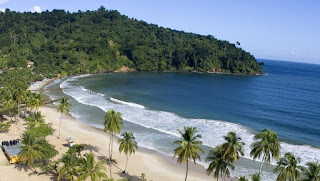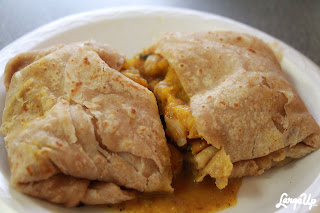The most popular beach in Trinidad, Maracas Bay is home to great tans, exciting surf and the wildly popular Bake and Shark.
Maracas Bay is Trinidad’s most popular beach. The wide, white-sand shore, dotted with palm trees contrasting against the backdrop of verdant mountains, remains an irresistible lure for both locals and travelers. On any given Sunday, Maracas Bay is never empty. Its beauty attracts beach lovers to this crescent coast line which stretches for 2 km (1. 25 miles). Call it a pilgrimage if you will. Making Port of Spain the departure point from the west side, the drive is about 16 km (10 miles) from the capital. From the east traveling through San Juan and via Santa Cruz, the trip may take just under an hour. From either direction stone pillars are the landmarks that welcome you to the North Coast Road. The tumbling waves, with an average height of 1 meter (3 feet), make it an ideal place for body or board surfing. The expanse of beach is enough to accommodate the sunbather who likes his/her space or the nature lover who welcomes the sea blast as they set up camp.
Maracas Bay has also garnered the reputation for being the lunch spot with an idyllic view. Known as the home of bake and shark, this destination is host to a variety of vendors who prepare the tasty offering. The secret, they say, is in the sauce. Really, the sauce!!
A bake and shark at Maracas Bay is truly an experience for both tourists and locals alike. In the list of things to do while visiting Trinidad “Having a Bake and Shark at Maracas Bay” should be high up on the list!
So what is Bake n Shark? Well it is basically fried dough and highly seasoned fried fish. That probably does not sound all that amazing or innovative but it really is all in the execution, and of course the sauces! The condiment bar is often as large as the fish stand and contains everything from cilantro sauces to garlic sauce, tamarind sauce, chopped vegetables and of course pepper sauce.
The taste is truly exquisite especially with all the sauces…Me, being the gree…ur! hungry person that I am, I must have all the sauces and sides which are available. So, on my rounds I must have my garlic sauce, chadon beni chutney, some hot pepper sauce, lettuce, cole slaw, ketchup, mango chutney, tomatoes, cucumber……somebody bring me a napkin, I’m dribbling here lol!!!
This is the real deal!! Bake and Shark was featured in an episode of "Bizarre Foods" hosted by chef and food critic Andrew Zimmern.
Check out the video and these pics below!












































